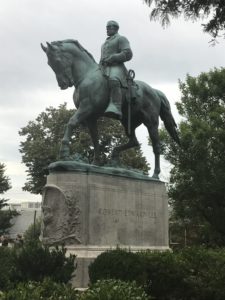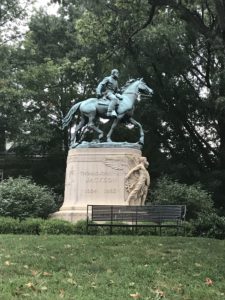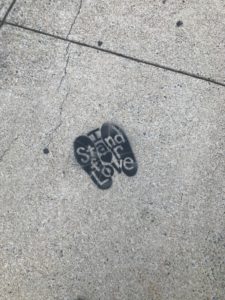Tools of Displacement
Originally published in Slate Magazine, June 23, 2017.
Written by University of Virginia College and Graduate School of Arts & Sciences Ph.D. candidates Sophie Abramowitz, Eva Latterner, and Gillet Rosenblith. Reposted with permission.
 Sophie Abramowitz specializes in 19th Century American, 20th Century American, African American, Cultural, and Sound Studies as a Ph.D. candidate in the Department of English at UVA
Sophie Abramowitz specializes in 19th Century American, 20th Century American, African American, Cultural, and Sound Studies as a Ph.D. candidate in the Department of English at UVA
 Eva Latterner specializes in 20th Century American and Gender and Sexuality Studies as a Ph.D. candidate in the Department of English at UVA
Eva Latterner specializes in 20th Century American and Gender and Sexuality Studies as a Ph.D. candidate in the Department of English at UVA
 Gillet Rosenblith specializes in African American Studies and the 20th Century United States as a Ph.D. candidate in the Corcoran Department of History at UVA
Gillet Rosenblith specializes in African American Studies and the 20th Century United States as a Ph.D. candidate in the Corcoran Department of History at UVA
How Charlottesville, Virginia’s Confederate statues helped decimate the city’s historically successful black communities.
Last week, Corey Stewart came within a hair’s breadth of claiming the Republican nomination for governor of Virginia after having run on a revanchist campaign focused on battling local efforts to rename and remake Confederate monuments and spaces. Even as Stewart’s campaign ended, the fight over these monuments in Charlottesville, Virginia, continued. They might soon reach a new fever pitch, and as they do it’s worth considering an overlooked piece of history around these statues: Their role in displacements of former black residents.
First as an update, here’s where that fight currently stands: Earlier this month, a resolution to rename Charlottesville’s two Confederate parks was passed by the Charlottesville City Council unanimously. Lee Park, the home of a controversial Robert E. Lee statue that the council previously voted to remove, will become Emancipation Park, and Jackson Park, the home of a statue of Stonewall Jackson, will become Justice Park. Meanwhile, locals are working on ways to counteract a Ku Klux Klan rally, proposed for July 8, and an alt-right March on Charlottesville headed by Richard Spencer, proposed for Aug. 12, at the site of the Lee statue’s eventual removal.
On May 13, University of Virginia alum and alt-right activist Spencer led a nighttime rally in Lee Park in protest of the council’s plan to remove the statue. This protest brought national attention to the battle between local activists and the outside alt-right and white nationalist forces whose actions drew comparisons to the Klan.

What has been missing from this fight, though, is the specific history of Charlottesville’s Confederate statues. Intimately tied to Charlottesville’s city planning projects and its persistent displacement of black residents, that context is emblematic of the relationship in the South between urban renewal and gentrification, Confederate memorialization and Lost Cause white supremacy, and the town-and-gown dichotomy inherent in university communities.
The statues of Jackson and Lee not only symbolize the violence of the ongoing displacements of gentrification; they also initiated and facilitated these changes when they were first put up. Strategically erecting these symbols of the Confederacy at the edges of or atop black and nonwhite immigrant communities provided Charlottesville’s white elite with a means of physically buttressing their ever-fragile hold of white supremacy. To understand this is to understand Charlottesville’s demographic population shifts throughout the 20th and 21st centuries and how the statues physically bisect those gentrifying spaces.
Lee’s statue was unveiled before thousands of attendees on May 21, 1924, during a two-day gathering of the Sons of the Confederacy at which the city also saw KKK agitation. With the University of Virginia President Edwin Alderman giving the statue’s dedication before several Confederate memorial groups, the ceremony represented a partnership between the state university and national organizations of the Confederacy in the monumentalization of the Lost Cause.
The ideology of the Lost Cause posits that noble and chivalrous Confederate soldiers and leaders fought the Civil War as a conflict over states’ rights rather than slavery. According to this mythology, post-emancipation black people misused their freedom and were, thus, inept American citizens. For Lost Cause supporters, this failure of black citizenship proved that white people were of an innately superior race and, following that logic, that slavery was beneficial to all.
While mob violence occurred relatively infrequently in the Shenandoah Valley, lynchings elsewhere in Virginia and the rest of the country were often a reaction to black economic success that counteracted these white supremacist theories. Charlottesville’s thriving black neighborhood, Vinegar Hill, was a prime example of one of these successful communities. The Lee statue, which was erected just a few blocks from Vinegar Hill, sent an obvious message to residents: Public space, public institutions, and public success are not for you.
The Jackson statue, meanwhile, was dedicated in Charlottesville’s Court Square in 1921 during the year’s reunion of the Confederate Veterans and the Daughters of the Confederacy. Depicting Jackson riding his horse into battle, the monument was unveiled from underneath a massive Confederate flag with 5,000 Confederate-nostalgic revelers looking on.

This monument to Jackson lies atop what was once a majority-black area known as McKee Row. In 1914, the Albemarle County Board of Supervisors confiscated the land from its black residents and granted it to the city. The city justified its action by noting its concern about the “rowdy” activity from McKee Row interfering with the Levy Opera showgoers. It also cited concern regarding the presence of young, presumably white, men “slumming” through the McKee Row neighborhood.
Jeffersonian disciple and journalist James Alexander rendered the connection between “rowdiness” and race explicit in his writings about McKee Row, remembering it as the site of “buildings of importance” that had tragically “declined into forlorn rookery,” emblemized through the presence of “ ‘Colonel Crack,’ a demented but harmless Negro.” To emphasize its punitive role vis-à-vis the black community, the statue itself was built over the former location of the Charlottesville jail. Panoptic and stern, the statue’s function was made clear in its position proximal to the former location of a whipping post.
Jackson Park was Charlottesville’s first gentrification project. The installation of Confederate monuments was a critical component of Charlottesville’s precrash 1920s period of rapid redevelopment. While there was a surge of Confederate memorialization directly succeeding the end of the Civil War, all of the Confederate monuments in Charlottesville, and many in other Southern cities, were installed in the 1920s as a way to materialize and reinforce Jim Crow within the expanding townscape.
At the turn of the century, Court Square was the subject of these city planning efforts, consisting of significant redevelopment that directly impacted the residents of McKee Row. Directly beside the Jackson monument sits the Albemarle County Courthouse, and yards away stands another statue of an anonymous Confederate soldier that was constructed in 1909. Flanking the Albemarle Courthouse, these statues worked together to mark the ostensibly public and civic space of the courthouse as the ideological property of the Confederacy. Both statues sport a Confederate flag and face south, which long suggested that the courthouse was committed to upholding the values represented by the flag.
Throughout the 20th century, the city of Charlottesville has precipitated multiple waves of urban renewal or gentrification. As James Baldwin put it, these sorts of efforts were actually more like “Negro removal.” The planning projects displaced black residents not only from their homes and communities, but from their businesses, their sources of wealth, and their proximity to institutions of socio-political power.
Installing Confederate monuments helped to facilitate and buttress these displacements both physically—by razing and demarcating the borders of black neighborhoods—and ideologically—by marking areas of political and financial power as part of the ideology of the Lost Cause. In the decades after the erection of the Lee statue, the best-known casualty in Charlottesville was Vinegar Hill.
A vibrant black neighborhood and business district effectively connecting the downtown mall to the University of Virginia, it was marked as “blighted” and completely razed in an urban renewal project in the mid-1960s. Its sole civic memorial is a small plaque at knee-height, obscured by potted vegetation, at the west end of the downtown mall shopping district. Its message, “Today Vinegar Hill is just a memory,” is a mere salve, while the Lee and Jackson statues are perpetual wounds.
In February, Showing Up for Racial Justice Charlottesville co-sponsored—along with the Jefferson School African American Heritage Center, Legal Aid Justice Center, NAACP, and the Charlottesville Public Housing Association of Residents—a workshop on gentrification, zoning, and form-based code to equip people with tools to help them fight for fair and just housing. These issues are live ones for Charlottesville, which is facing a modern gentrification fight over Friendship Court, one of Charlottesville’s public and subsidized housing developments at the edge of the downtown shopping center that is currently slated to be torn down and replaced with mixed-income and mixed-use development.
The ongoing whitelash against removal of the Confederate statues doesn’t necessarily reflect the strength of white supremacy today. It is rather a sign of its enormous fragility. It is a sign that those who seek justice can win. Perhaps not all at once and almost certainly not once and for all. Recognizing not just the historic symbolism of these statues, but also their practical effects is a good first step.
- 4th Annual UVA Student Oratory Competition
- UVA Clubs: "Through the Lens" with Gerard Robinson
- Virtual Presentation & "Ask me Anything" with a Certified Nutritionist
